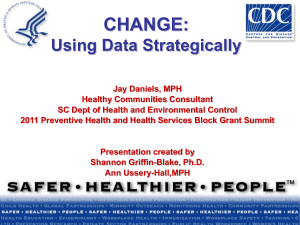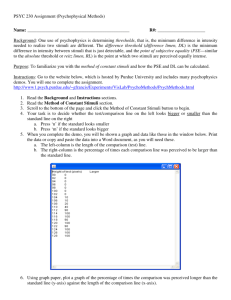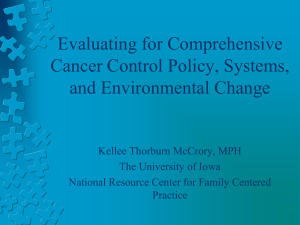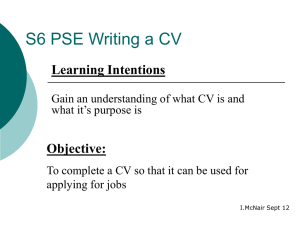(PSE) Change Approaches - Iowa Cancer Consortium
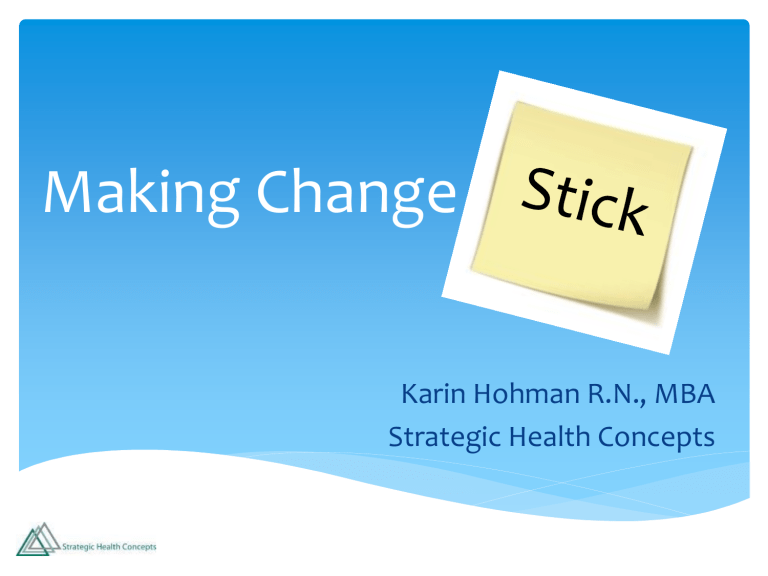
Making Change
Karin Hohman R.N., MBA
Strategic Health Concepts
Overview
What is Policy, System, and Environmental change
(aka = PSE)
What works in cancer control PSE approaches
Ways to work together to make PSE changes stick
The problem…
“It is unreasonable to expect that people will change their behavior easily when so many forces in the social, cultural, and physical environment conspire against such change”
Smedley and Syme, 2000
…forces conspiring against change
Worksites
Communities Schools
Restaurants and Shops
Health Care
Media
Can we change policies, systems, and the environment to support healthy choices?
Worksites
Communities Schools
Restaurants and Shops
Health Care
Media
Policies, systems and the environment around us
Policies - rules that encourage or discourage certain behavior
System changes – changes in how things are done in an organization or setting
Environmental changes – changes in places we work, play, shop, go to school
Strengths of policy, system and environmental changes
Effort is ongoing – not episodic with a start and end
Supports a population behavior change – not a 1:1 approach
Usually lower in cost with a high impact
Change is built to last– it sticks
In other words….
Establish a safe community use fishing pond
PSE Change
PSE simplified
PUT UP a BARRIER to make something harder to do
OR
REMOVE a BARRIER to make something easier to do
Ways to PUT UP a barrier
Increase the tobacco tax
Create a policy that pop or candy is not available for purchase in schools
Restrict ages that can utilize tanning beds
Create a system where you must record cancer screening test history in an electronic medical record
Ways to REMOVE a barrier
Employers offer reduced gym memberships
Establish a community farmers market for fresh produce
Institute a patient navigation program
Set up a physician office reminder system
How is PSE different?
Events
Display posters during National
Nutrition Month
Open the school gym during a community fair
Promote “Bike to Work” Day
Provide a healthy lunch at a work meeting
Sponsor a screening fair at work
Policy, Systems and
Environmental Change
Add more / different fruits & vegetables to cafeteria choices
Develop a shared use agreement with the school
Provide secure bike parking areas and showers
Adopt a healthy food meeting policy
Allow time off every year for employees to get screened
Adapted from ‘Understanding Policy, Systems, and
Environmental Change to Improve Health’.
Presentation by Brooke Ahlquist, MA, MPH
Where do PSE change approaches work best?
The full continuum of cancer…Prevention,
Early Detection, Diagnosis and Treatment,
Quality of Life, Survivorship to End of Life
Pretty much any setting…schools, work, communities, home, businesses, health care clinics, hospitals
The most effective approach is a comprehensive approach
Community
Government Worksites
Restaurants and Shops
Health Care Media
Schools
Reduce tobacco use = a comprehensive approach
Community
Government Worksites
Restaurants and Shops
Health Care Media
Schools
Reduce tobacco use initiation and current use
Policy Change –
Raise the cost of tobacco by
10% and adolescent tobacco use drops by 3.7 %
Reduce exposure to second hand smoke
Policy Change
Restrict by law where people can smoke and voluntary restrictions in places such as cars and homes
Decrease obesity rates = a comprehensive approach
Community
Restaurants and Shops
Worksites
Health Care Schools
Media
Promote and increase access to active transportation
Environmental Change
Encourage and enable biking/walking to a destination
Increase access and availability of healthy foods and beverages
Environmental Change
Make it easier at work, school and events to get healthy foods and beverages
And harder to get less healthy options
Increase use of food from local farms
Environmental Change
Support local farmers by promoting fresh, local foods
Increase access to physical activity opportunities
Environmental Change
Develop, clean up and promote trails, fitness centers, community centers, and playgrounds
Increase cancer screening rates = a comprehensive approach
Appropriate
Affordable Accessible
Acceptable Available
Make screening more convenient
System Change –
Change hours of service, offer screening in other settings, offer transportation and child care, simplify paperwork
Reduce costs for screening
Policy change
Reduce costs through a variety of approaches: increase awareness of benefits, issue vouchers, increase employee benefits
Use reminder systems
System Changes
Patient Reminders
Provider Reminders
Provide patient navigation
System Change
1 on 1 support to help navigate the patient through their cancer treatment process
Increase access to treatment
Policy Change
Advocate for insurance coverage for clinical trials
Assure palliative care services
Systems change –
Increase the number of physicians and nurses who are board certified in palliative care
Support cancer survivors
System and policy changes
Increase the number cancer centers that work with patients to develop survivorship care plans
Keys to PSE success
Start with what works and build on that
Make one change, even if it is small
Get the right people at the table
Look for “win-win” opportunities
Over-Arc hing Issues
Health Disparity closely linked with social or economic disad-
The Iowa Cancer Plan addresses six overarching health issues critical to the success of comprehensive cancer control in Iowa. To accomplish each goal, these issues must be incorporated during implementation of priorities, strategies, and action steps listed in the plan.
groups of people who have systematically experienced greater social and/or economic obstacles to health and/or a clean environment based on their racial or ethnic group; religion; socioeconomic status; gender; age; mental health; cognitive, sensory, or physical disability; sexual orientation; geographic location; or other characteristics historically linked to discrimination or exclusion.” 5
Health Equity
“The absence of systematic disparities in health (or its social determinants) between more and less advantaged social groups.” 6
Health Policy
“Refers to decisions, plans, and actions that care goals within a society. An explicit health
A colored ' ’ near a strategy indicates that the strategy and its corresponding action steps
Collaboration
The Iowa Cancer Plan calls for partnerships between organizations, coalitions, businesses, and individuals to maximize resources and reduce duplication.
Coordination, cooperation, and partnership are essential to a comprehensive approach to cancer. In the spirit of collaboration, this plan aligns with other organizations’ plans and goals when possible.
Disparities
The Iowa Cancer Plan addresses cancer health disparities and promotes health equity in
Iowa.
Health disparities exist in cancer services among every population in Iowa, including those based on geography, age, socioeconomic status, race, ethnicity, and culture. The implementation of every strategy in this plan must counter associated cancer-related disparities and inequities so that every Iowan can expect the best outcome possible. a vision for the future which in turn helps to establish targets and points of reference for the short and medium term. It outlines groups; and it builds consensus and informs people.” 7
Workforce
The Iowa Cancer Plan addresses cancer workforce needs.
PSE approaches in the
Iowa Cancer Plan receive access to the quality services and care they need.
The 2012-2017
Iowa Cancer Plan is a living document.
As the world of cancer evolves, this plan will evolve, too. Visit www.CancerIowa.
org to view the interactive and ever-changing version of the plan.
Policy and Systems
The Iowa Cancer Plan promotes advocacy for policy and systems change.
According to the Centers for Disease Control and Prevention, “The policies, systems, and environments around us, including our communities, worksites, transportation systems, schools, faith-based organizations, and health-care settings shape the pattern of our lives and our health.” 8 It is necessary for change and partnerships to occur at these foundational levels to make optimal cancer prevention, screening, treatment, and quality-of-life opportunities accessible to all Iowans.
5. National Partnership for Action to End Health Disparities. (2011). Health Equity & Disparities. Retrieved May 13, 2011 from
8
Journal of Epidemiology and Community Health, 57(4), 254-258.
7. World Health Organization. (2011). Health topics: Health policy.
8. Centers for Disease Control and Prevention. (2010). Putting communities to work: Policies, systems, and environmental change. Retrieved May 13, 2011,
Examples of PSE approaches in the
Iowa Cancer Plan
Examples of CCC PSE efforts
Illinois- working with FQHC’s and colorectal cancer to assure systematic screening
Michigan – policy scan; what services health care systems are providing cancer patients have available to them. Looking for gaps
Montana – working with worksites to increase cancer screening – starting with finding the win-win opportunity
Partnerships are key to success in PSE efforts
Partnerships…finding the ‘Sweet Spot’
The “Sweet Spot”… the Iowa Cancer Consortium
No one organization can do this alone
Multiple organizations provide credibility and importance to the cancer plan
Increases likelihood of success due to widespread support
Leverages partner strengths and relationships
Brings together a range of expertise and resources
If one partner goes away, the effort doesn’t stop
Who does what?
Partnership Roles
Convener
Communicator
Guide
Educator
Planner
Supporter
Ask yourself…
What role do you see your organization (or you) playing in the following scenarios?
An effort to increase Iowa’s tobacco tax?
Establishing a patient reminder system?
A policy to assure survivorship care plans?
Keys to PSE success
Start with what works and build on that
Make one change, even if it is small
Get the right people at the table
Look for “win-win” opportunities
Thank you
Karin Hohman
Strategic Health Concepts
303-906-9336 karin@shconcepts.com
